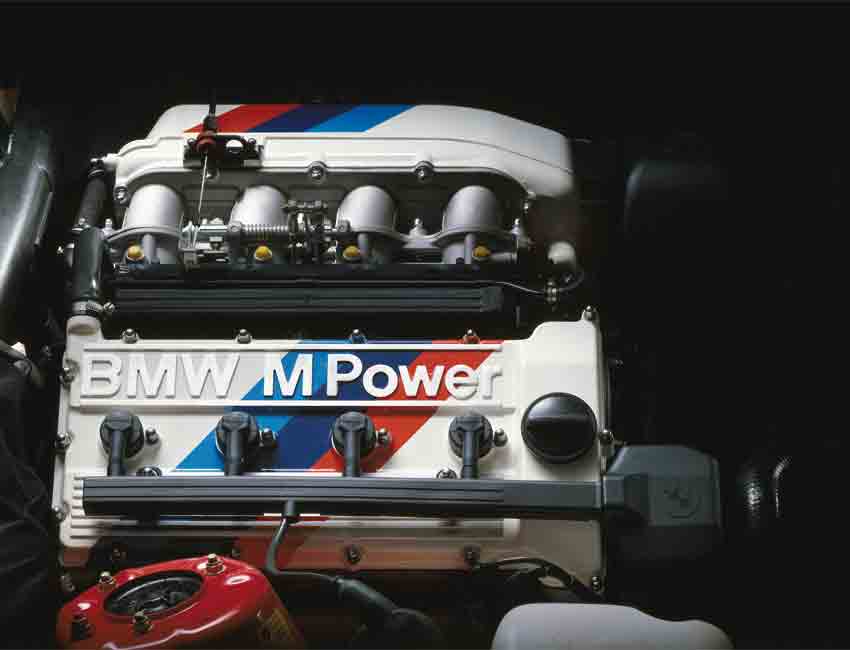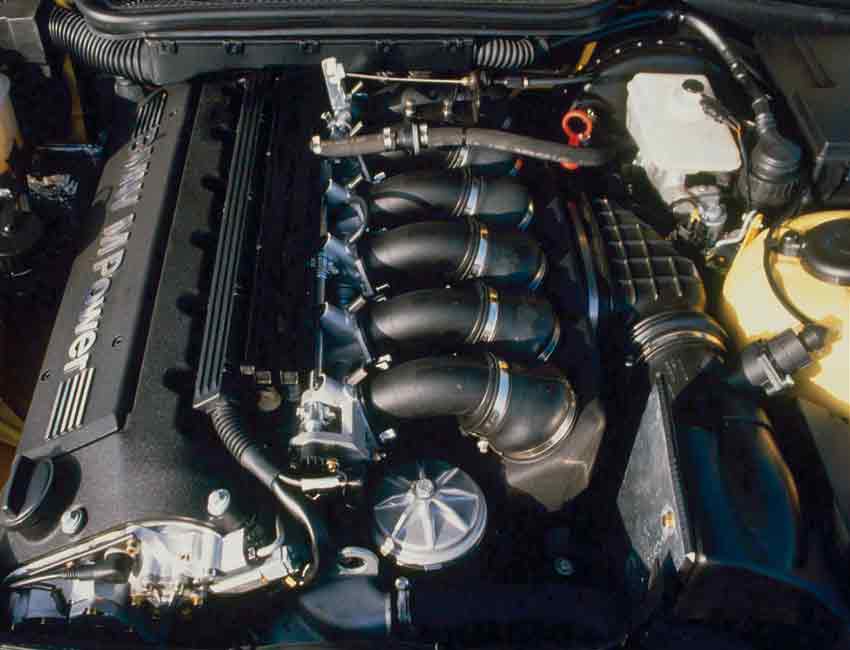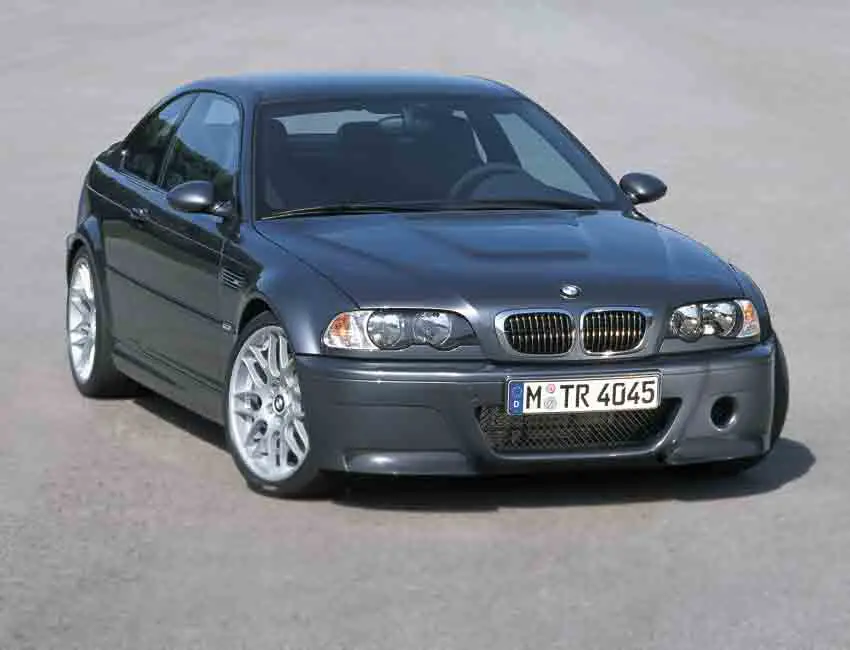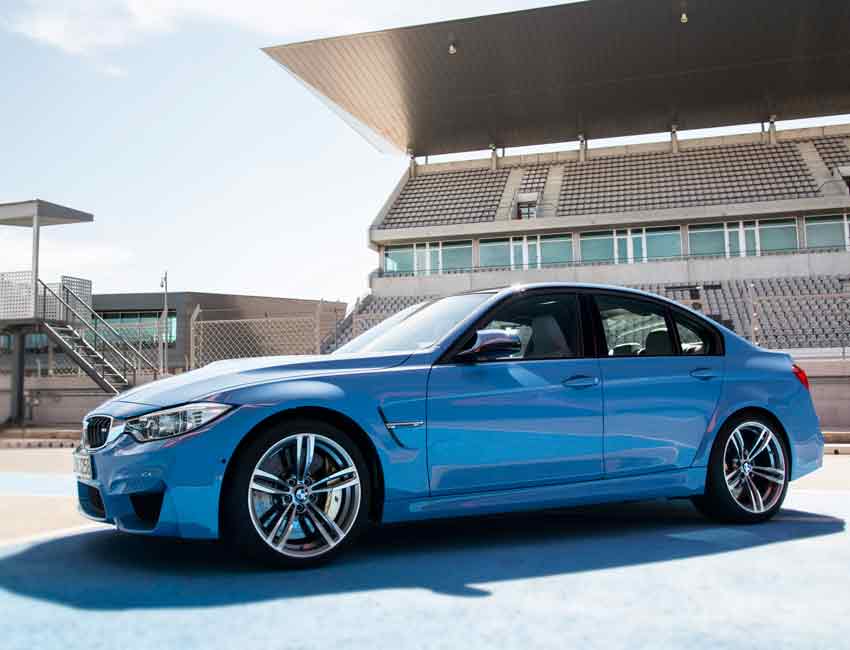After three decades and five generations of transformation, innovation, and refinement, the iconic BMW M3 continues to sophisticate in all aspects. It held its reputation high as one of the most sought-after performance vehicles in its class.
During the 2014 International Auto Show in Detroit, Michigan, the highly anticipated M3 Sedan took the stage alongside its new variance – the M4 Coupe.
The Latest BMW M3 Sedan
Boasting many similarities to today’s BMW M4 Coupe, the BMW M3 is considered the ancestor and inspiration for the new rising-star coupe. Today, the 4-door sedan became the official body type for the latest BMW M3 model, and the prior generation M3 Coupe was made over into the new 425 HP and 405 lb-ft torque F82 M4.
For the past 30 years, this German-engineered supercar never ceased to revolutionize its pioneering development. So, let us turn the pages back and unfold where the evolution had all begun.
A Brief History of the BMW M3
In 1985, Munich, Germany, at the headquarter of the BMW Motorsport GmbH, the company’s then managing director Paul Rosche came up with the idea of the BMW M3. Production began swiftly after, and the 17,970 units completed and sold were all originated from the BMW plant right next door.
This was the very first generation of the BMW M3, and it marked the beginning of a sports car legend. In the following years, there were a total of 222,293 combined production units accounted for the second, third, and fourth generations since 1992.
Today, the new BMW M3 Sedan and BMW M4 Coupe symbolize the fifth generation of driving excellence and aerodynamics of the iconic mid-size sedan and coupe class.
Dr. Friedrich Nitschke, President BMW M GmbH, reminisced at the debut of the New BMW M3 and M4 in 2013:
“The BMW M3 has been our iconic model in the high-performance sports car segment since 1985, when the company unveiled the first generation of the BMW M3 at the International Motor Show (IAA) in Frankfurt. Today, 28 years later, the new BMW M3 Sedan and new BMW M4 Coupe are set to extend this tradition into a fifth generation and take the car’s unique combination of outstanding dynamics and unrestricted everyday usability to yet another new level.”
The BMW M3 Production Story

The manufacture of the first M3 began at its Munich plant. Now at almost 30 years later, the BMW M4 returned to the birthplace to commence its official production. The M3 production, on the other hand, was hosted at the Regensburg Plant where the second through the fourth generations of the M3 was produced.
BMW explained that the reason and significance of separating production facility was to focus the effort on “the company’s commitment to integrating the two high-performance sports cars into the production processes for their respective donor models”, hence the 3 Series and 4 Series.
“The ‘mixed’ production,” addressed by BMW, “can respond quickly to market fluctuations by making adjustments to unit figures as required. As well as efficient production planning and logistics, the essential ingredient in this approach is the single-line system: both M models will be built alongside their respective donor models on the same production line.”
First Generation: BMW M3 E30 History
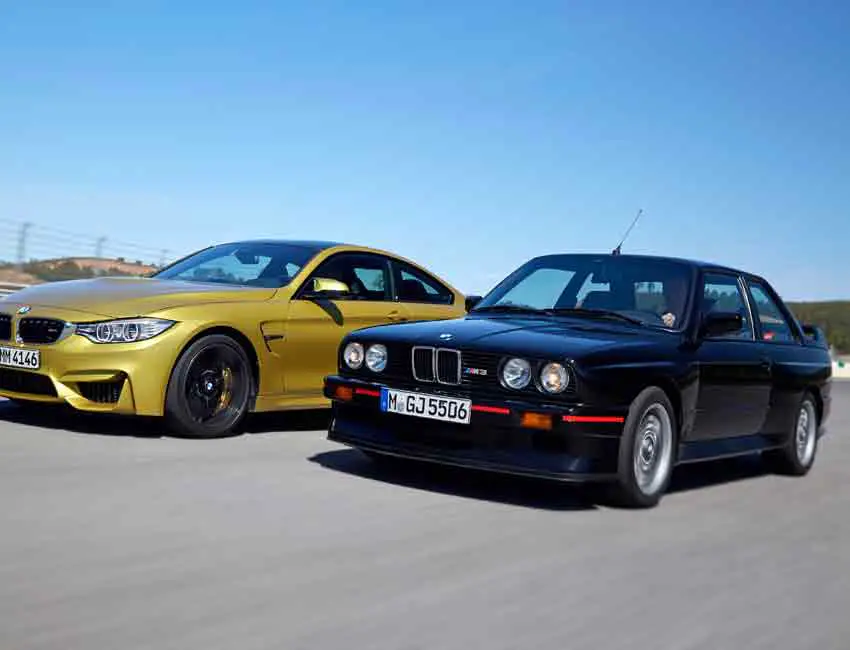
The very first BMW M3 model made its initial appearance in the 1985 Frankfurt Motor Show in Germany.
What Makes the BMW M3 E30 Special?
The 200 HP rear-wheel drive was initially built for track purpose only. In order to comply with the touring car competition Group A sporting regulations, 5,000 units of the street-legal version required for homologation had to be built for sale each year.
The European street version of the first-generation BMW M3 E30 officially began production in the spring of 1986. The car quickly became the iconic racing sensation as it rivaled its competitions and snatched several Touring Car Championships in Europe.
As the new flagship gained popularity and recognition all around the world, the BMW M3 E30 North American version production took place in 1987, and in 1988 its official release was announced. By the time production of the first generation had ended during 1991, worldwide sales of the road-going Coupe was a total of 17,970 units sold.
BMW M3 E30 Specifications
BMW M3 E30 First Production Dates
- 1986 (Europe)
- 1987 (North America; released in 1988)
BMW M3 E30 Horsepower
- 195 HP (Catalyst* European Version & Twin In-line Catalyst North America Version)
- 200 HP (Non-catalyst European Version)
- 215 HP (Catalyst Version)
- 220 HP (Special Edition Evolution II)
- 238 HP (Special Edition Sport Evolution)
*Note: Catalyst is a pollution control device that converts unsafe substances produced through the car’s exhaust into non-toxic substances.
The BMW M3 E30 Engine
- 2.3-liter 4-Cylinder (S14 B23)
The BMW M3 E30 Transmission
- 5-speed manual
BMW M3 E30 Torque
- 170 lb-ft at 4,750 RPM (195 HP; Catalyst; North America Version)
- 176 lb-ft at 4,750 RPM (200 HP; Non-catalyst; European Version)
- 170 lb-ft at 4,600 RPM (215 HP, Catalyst; Include the Limited Editions Johnny Cecotto & Roberto Ravaglia)
- 181 lb/ft at 4,750 RPM (220 HP, Non-catalyst; Evolution II)
BMW M3 E30 Acceleration
- 0-60mph in 6.8-sec (200 HP Coupe)
- 0-60mph in 6.6-sec (215 HP Coupe)
- 0-60mph in 6.7-sec (200 HP, Evolution I)
- 0-60mph in 6.1-sec (220 HP; Evolution II)
- 0-60mph in 6.1-sec (238 HP; Sports Evolution)
- 0-60mph in 7.4-sec (200 HP Convertible)
- 0-60mph in 7.3-sec (215 HP Convertible)
The BMW M3 E30 Wheels
- 15-inch alloy cross-spoke
BMW M3 E30 Production Versions
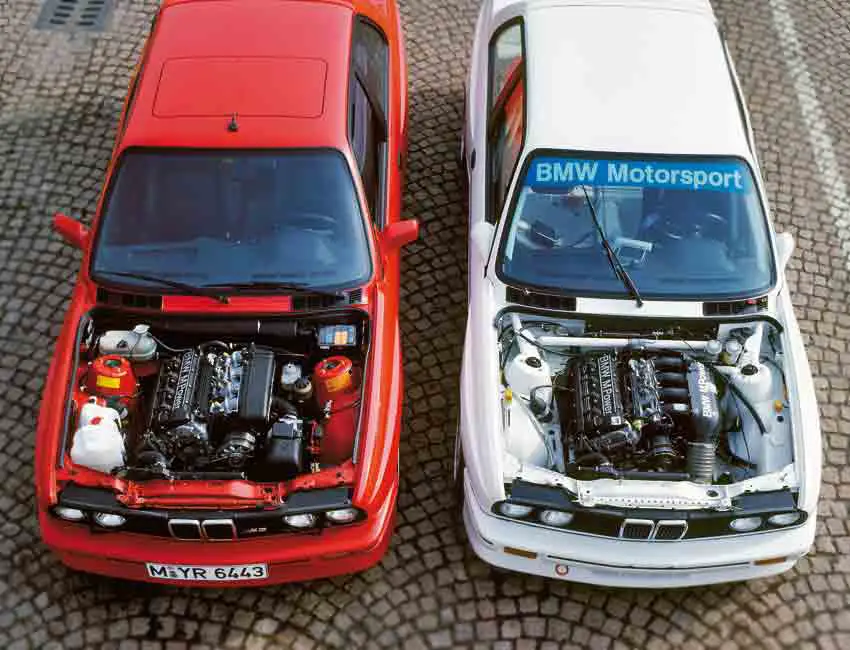
The BMW M3 E30 Coupe had a total of 11 production versions with mechanical and cosmetic variations. Of which four were standard production versions with mechanical upgrades, three were limited edition versions with mechanical upgrades, and there were four more special editions with mainly cosmetic upgrades. There were also three versions of the M3 Convertible that was a hand-assembled limited lot.
Standard BMW M3 E30 Production Versions with Mechanical Upgrades
- European Non-catalyst version with 200 HP
- European Catalyst* version with 195 HP
- European Catalyst version with 215 HP
- North American Catalyst version with 195 HP
*Note: Catalyst is a pollution control device that converts unsafe substances produced through the car’s exhaust into non-toxic substances.
Limited Edition BMW M3 E30 Production Versions with Mechanical Upgrades
- Evolution I (Non-catalyst; 200 HP)
- Evolution II (Non-catalyst; 220 HP)
- Sport Evolution (Catalyst; 238 HP)
Special Edition BMW M3 E30 Productions Versions with Cosmetic Upgrades
- Tour de Corse (Non-catalyst; French Edition)
- Europa Meister 88 (Catalyst)
- Johnny Cecotto (Catalyst; Swiss Edition)
- Roberto Ravaglia (Catalyst)
Limited Edition BMW M3 E30 Convertible
- European Non-catalyst version (200 HP)
- European Catalyst version (195 HP)
- European Catalyst version (215 HP)
Second Generation: BMW M3 E36 3.0 and 3.2 History

Like the M3 E30, the second generation of the BMW M3 E36 was boasted in distinctive cosmetic and power upgrades from its 3 Series engineered designs.
What Makes the BMW M3 E36 Special?
Different from the E30, the M3 E36 was built specifically for the everyday road. The production model came in three body types. The 2-door coupe and convertible in 1992 as well as the 4-door sedan in 1994. It was the very first time that the M3 model brought on a 4-door sedan.
The Evolution of the BMW M3 E36
In 1992 Paris Motor Show, the M3 E36 3.0 Coupe came equipped with a brand-new engine – S50 B30. It offered individual throttle bodies and Variable Valve Timing System (VANOS or Variable Nockenwellen Steuerung). The new model received an overwhelming response from the United States enthusiasts.
In 1994, the Coupe in U.S. specs (without individual throttle bodies and VANOS in order to keep the cost down) made its American public debut at the Los Angeles International Auto Show. While in the same year, the sedan and convertible versions were produced and made available only in Europe.
In 1995, BMW Motorsports fitted the newer models of E36 with a higher performance 3.2-liter engine S50 B32 (M3 E36 3.2 Coupe) and presented its latest craft at the Frankfurt Motor Show. Production in Europe began a year later.
In 1996 at the New York International Auto Show, the new United States Model of the M3 E36 3.2 was being announced with a specialized S52 engine and electrical traction control system ASC+T (Automatic Stability Control + Traction Control).
At 1997, the M3 reached a new height by becoming the world’s first volume-produced car to introduce Sequential M Gearbox (SMG) as optional equipment. Built based on the conventional gearbox, the gear change could happen with a clutch that was activated electro-hydraulically. There was no more need to press the clutch pedal, and the drivers could easily and instantaneously shift by pulling or pushing the gearshift leveler.
By this time, 71,242 units of the M3 Coupe, Convertible, and Sedan combined were produced in Regensburg.
BMW M3 E36 Specifications
BMW M3 E36 First Production Dates
- 1992 Europe (E36 3.0 Coupe)
- 1994 Europe (E36 3.0 Sedan and Convertible)
- 1994 North America (E36 3.0 Coupe Only)
- 1995 Europe (E36 3.2 Sedan)
- 1996 Europe (E36 3.2 Coupe)
- 1996 Europe (E36 3.2 Convertible)
- 1996 North America (E36 3.2 Coupe)
- 1996 North America (E36 3.2 Sedan)
- 1997 North America (E36 3.2 Coupe)
BMW M3 E36 Horsepower
- 240 HP (United States Version; Include Both the E36 3.0 and E36 3.2)
- 286 HP (European Version; E36 3.0; Dual Catalyst*)
- 321 HP (European Version; E36 3.2)
*Note: Catalyst is a pollution control device that converts unsafe substances produced through the car’s exhaust into non-toxic substances.
The BMW M3 E36 Engine
- 3.0-liter 6-Cylinder (S50 B30)
- 3.2-liter 6-Cylinder (S50 B32)
The BMW M3 E36 Transmission
- ZF Type C 5-Speed Manual (North America Version; E36 3.0)
- ZF 5HP18 5-Speed Automatic (North America Version; E36 3.0)
- Getrag 6-Speed Manual Transmission (European Version; E36 3.2)
- Sequential Manual Gearbox or SMG (European version; E36 3.2)
BMW M3 E36 Torque
- 236 lb-ft at 3,600 RPM (European Version; E36 3.0; 286 HP; Dual Catalysts)
- 225 lb-ft at 4,250 RPM (United States Version; E36 3.0; 240 HP)
- 258 lb-ft at 3,250 RPM (European Version; E36 3.2 321 HP)
- 236 lb-ft at 3,800 RPM (United States Version; E36 3.2; 240 HP)
BMW M3 E36 Acceleration
- 0-60 mph in 6.0-sec (European Version; E36 3.0)
- 0-60 mph in 6.1-sec (United States Version; E36 3.0)
- 0-60 mph in 5.5-sec (European Version; E36 3.2)
- 0-60 mph in 6.1-sec (United States Version; E36 3.2)
BMW M3 E36 Wheels
- 17-Inch Alloy M Double-Spoke (E36 3.0)
- 17-Inch Alloy Forged M Double-Spoke (A Performance Option; E36 3.0)
BMW M3 E36 3.0 and 3.2 Production Versions
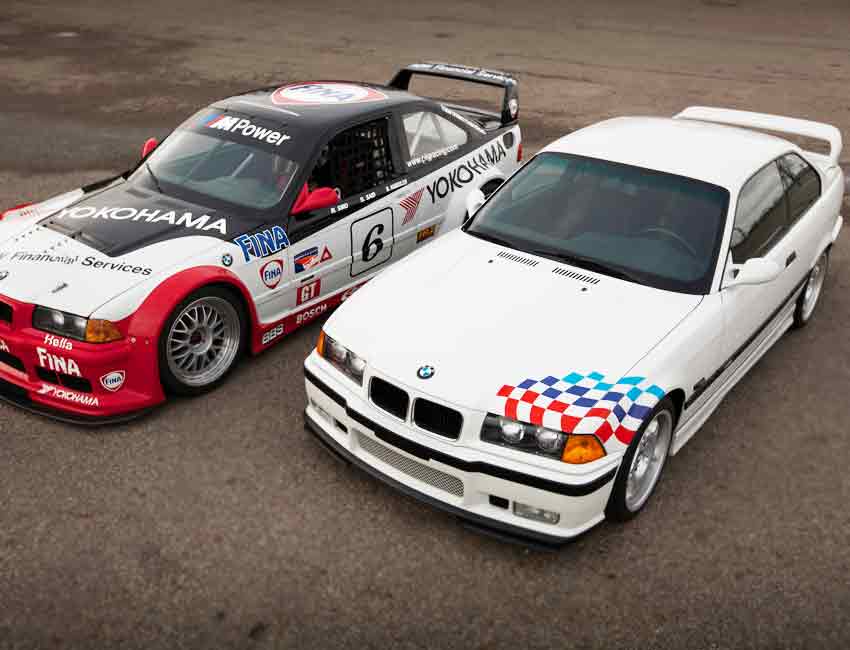
The BMW M3 E36 3.0 had a total of eight production versions. Of which three versions were standard production that included the European sedan and convertible models, and the remaining three were limited editions made for the European and United States market.
In addition, there were two more special built editions with only a handful of samples that were not at all commonly distributed in the market.
The BMW M3 E36 3.2, on the other hand, did not have any official variations in special production versions. However, exclusive special orders were requested from the United Kingdom and Australia markets in limited numbers.
Standard M3 E36 3.0 Production Versions
- E36 M3 3.0 Coupe (Europe and United States)
- E36 3.0 4-Door Sedan (Europe Only)
- E36 3.0 Convertible (Europe Only)
Limited Edition M3 E36 3.0 Production Versions
- E36 M3 3.0 GT Coupe (Europe)
- E36 M3 GT Individual (UK Only)
- E36 M3 CSL or M3 Lightweight (United States Only)
Special Edition M3 E36 3.0 Production Versions
- E36 M3-R (Australia); (GT production class competition car for Australian Super Production. Only 15 units were produced)
- E36 M3 GTR (Road Version); (This is the road going version of the E36 M3 competition car for 1994 ADAC German GT Cup Touring Car. Only two street-legal versions were produced)
Unofficial Special Edition M3 E36 3.2 Production Versions
- E36 M3 Coupe in Imola Red (UK Only)
- E36 M3 Convertible in Carbon Black Metallic (UK Only)
- E36 M3 Coupe Anniversary Edition (Australia)
- E36 M3 Convertible Anniversary Edition (Australia)
Third Generation: BMW M3 E46 History
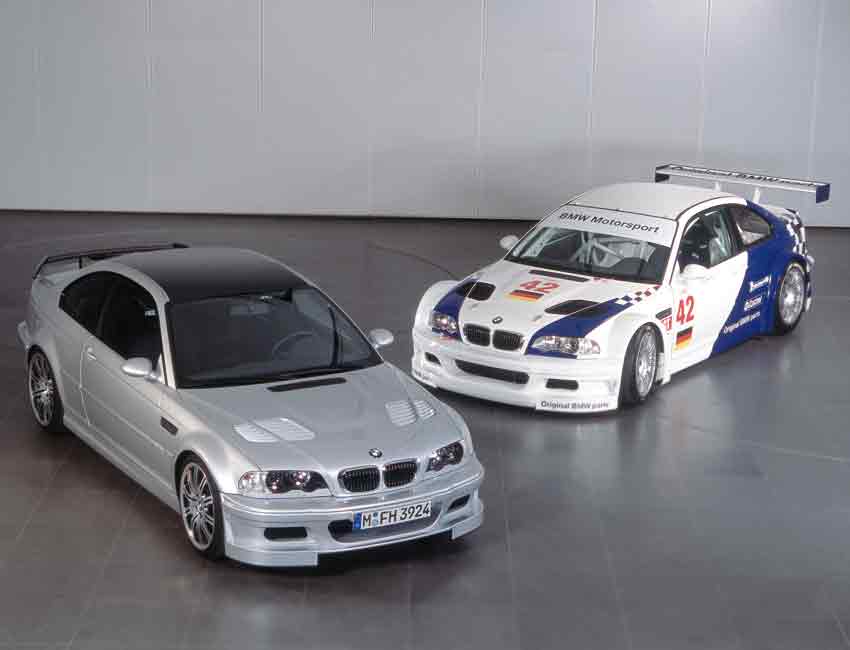
In 1999, returned to the Frankfurt Motor Show, the new high-performance concept BMW M3 E46 made its compelling entrance to the public. In 2000, the European M3 E46 production model was completed and showcased at Geneva Motor Show.
What Makes the BMW M3 E46 Special?
The improvements made to the M3 E46 were pleasantly sophisticated, to say the least. There were a number of aesthetic and functionality modifications such as the following:
- New Titan Shadow Interior Trims
- Updated Navigation System
- First Innovative Adaptive LED Taillights
- Auto Climate Control
- BMW Assist
- Bluetooth Wireless Phone Interface
Furthermore, one of the most distinctive upgrades that brought out the BMW M3 performance characteristics was the signature bulging power dome on the bonnet (hood) of the car.
More impressive enhancements were made in regards to the power upgrades. In the third generation M3, there were three important additions to the E46 as listed below.
The 3 Most Important Additions to the BMW M3 E46
1. Second Generation Sequential Manual Gearbox (SMG II) in the BMW M3 E46
SMG II was the improved version of the M3 E36’s Sequential Manual Gearbox (SMG). It was the concept of having an electrohydraulic clutch system controlled and operated by an electronic gearbox referred to as the BMW DriveLogic.
SMG II provided 11 changeable options in gear shift, of which six of those were “sequential” or manual mode and the remaining five were in “automated” or automatic shift mode.
Launch Control was also part of the system which optimized the acceleration. In addition, SMG also allowed the driver to change gears using paddle shifters located on the steering wheel.
2. Special Edition Dynamic Stability Control (DSC) Customized for the BMW M3 E46
The special DSC was designed to electronically control the suspension of the car, maintain maximum traction of wheels, and to keep the optimal stability of the drive. DSC can automatically calibrate to make minor adjustments to the car during oversteering or understeering. DSC can also apply brake forces to individual wheels when needed to keep the car in its course.
3. The BMW M3 E46 M Differential Lock
For this generation of M3s, the M Differential Lock located on the rear axle allowed a wide range of 0 to 100 percent lock. It came as standard equipment on every M3 E46. Its main function was to further control stability of the car in addition to providing superior tractions. This also ensured that the rear-wheel-drive carried out its utmost performance standards and retained its highest stability controls even on undesirable road conditions.
BMW M3 E46 Specifications
BMW M3 E46 First Production Dates
- 2000 (Europe; E46 Coupe)
- 2001 (Europe; E46 CSL Convertible)
- 2001 (North America; E46 Coupe and Convertible)
- 2003 (Europe; E46 CSL Coupe)
BMW M3 E46 Horsepower
- 343 HP
The BMW M3 E46 Engine
- 3.2-liter 6-Cylinder (S54 B32)
The BMW M3 E46 Transmission
- Getrag Type D 6-Speed Manual Gearbox with M Variable Differential Lock and optional Sequential Manual Gearbox II (SGM II)
BMW M3 E46 Torque
- 262 lb/ft of torque at 4,900 RPM
BMW M3 E46 Acceleration
- 0-60 mph in 5.2-sec
The BMW M3 E46 Wheels
- 18-Inch Cast Alloy M Double-Spoke II with Satin Chrome Finish (E46 Standard Wheels)
- 19-Inch Forged M Double-Spoke II with Satin Chrome Finish (Optional Upgrade)
- 19-Inch Cast Alloy Cross-Spoke (for M3 ZCP and M3 ECS Models)
- 19-Inch Cross-Spoke (M3 CSL); (This unique design is offered for the M3 CSL, and the design is closely simulated to the Cross-Spoke offered for M3 ZCP and M3 ESC)
BMW M3 E46 Production Versions
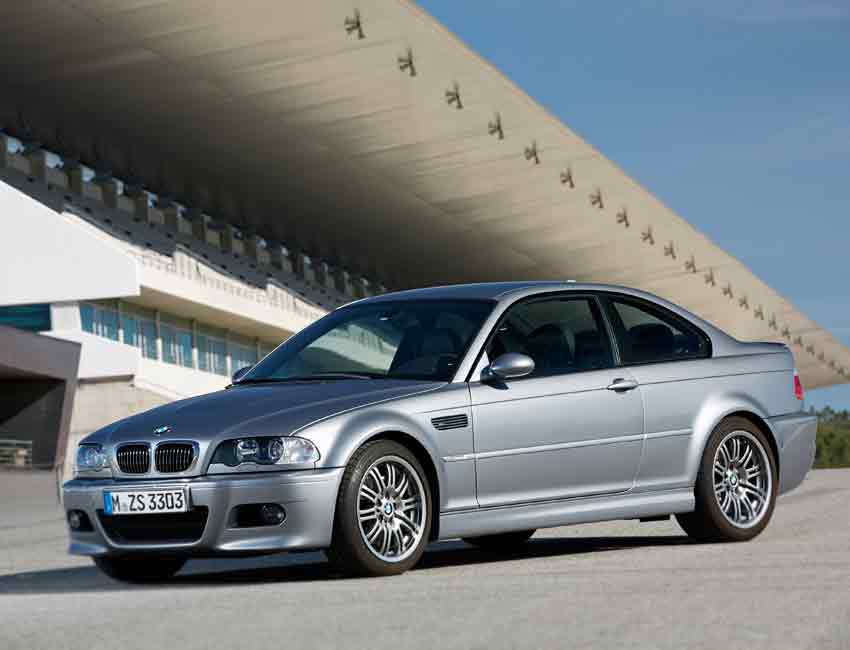
Eight official production versions of the BMW M3 E46 were accounted for. They were the Left-Hand Drive (LHD) and Right-Hand Drive (RHD) versions of the M3 E46 Coupe and Convertible in European specifications as well as North America specifications.
Then there was the special edition called the M3 E46 CSL (Coupe Sport Lightweight). This model was built for the European market only and was composed of several specialized lightweight components such as Carbon-Fiber-Reinforced-Plastic.
Standard BMW M3 E46 Production Versions
- E46 M3 Coupe (European Version LHD; 2000)
- E46 M3 Coupe (European Version RHD; 2001)
- E46 M3 Coupe (North America Version LHD; 2001)
- E46 CSL M3 Convertible (Europe Only; LHD; 2001)
- E46 CSL M3 Convertible (Europe Only; RHD; 2001)
- E46 M3 Convertible (North America; LHD; 2001)
- E46 CSL M3 Coupe (Europe Only; LHD; 2003)
- E46 CSL M3 Coupe (Europe Only; RHD; 2003)
Limited Edition BMW M3 E46 Production Versions
- BMW M 30th Anniversary Edition (Germany Only; 2002)
- M3 Silverstone Edition (UK Only; 2004)
Special Edition BMW M3 E46 Production Versions
- E46 M3 GTR (2001) (Homologation model for American Le Mans Series racing and not generally available to the public)
- E46 M3 CSL (“Coupe Sport Lightweight”; 2003) (Available to the public)
Fourth Generation: BMW M3 E90/E92/E93 History

In 2007, came the fourth generations of the BMW M3. Compared to its predecessors, the word “upgrade” does it no justice.
What Makes the BMW M3 E90, E92, and E93 Special?
Everything about this generation was greater, better, faster and more efficient – starting with the aggressively customized V-8 engine and all its unconstrained 414 horsepower. The transformation was completed with a total rework of the exterior body style as well as the restyling of the interior.
The Debut of the BMW M3 E90/E92/E93
The concept model of the new design was revealed during the Geneva International Motor show in spring of 2007. Six months after the fact, the official production version came under the limelight at the Frankfurt International Motor Show.
It was not until October 2007, the M3 E92 Coupe was shown to the public at the Tokyo Motor Show in Japan, and soon to follow was the debut of the E90 sedan. The E93 convertible premiered a year later in the Geneva International Motor Show.
Cosmetic and functional upgrades were made to the new M3 line-up such as the new paint colors, manually adjustable front seats with heat options, Carbon-Fiber-Reinforced-Plastic (CFRP) roof, aluminum hood with power dome, and the new LED taillight design featuring luminous strips.
In addition, there were 5 notable innovations that made the M3 E90, E92 and E93 unique during the 7 years they were in production.
The Top 5 Innovative Upgrades of the BMW M3 E90/E92/E93
1. The First of the BMW M Double Clutch Transmission or DCT
The 7-Speed Dual Clutch Transmission was first launched in the M3 E90/E92/E93. It was a compact design of the two gearboxes combined in one housing. The gearboxes were meant to work interchangeably in order to eliminate interruption during gear change and ensure smooth power flow.
2. Power-Upgraded to the 90-degree V8 Engine S65 B40 (From the E46 6-CylinderS54 B32)
The S65 B40 was a lighter but more powerful engine that operated on a Double VANOS Variable Valve timing system in the M3 E90/E92/E93.
3. The Introduction of the “A” Automatic Engine Start/Stop Function in the M3 E90/E92/E93
The automatic engine start/stop function stopped the engine when the car was at a complete halt in order to lower fuel consumption and CO2 emission.
4. The Addition of the POWER Button
The POWER button was located on the Center Console. By pressing this button on the M3 E90/E92/E93, throttle response and acceleration sensitivity would increase as the pedal became more sensitive.
5. Optional “ZCP” Competition Package
The ZCP Competition Package is exclusively available in the 2010 and Later M3 E90 Sedan, as well as in the M3 E92 Coupe.
The ZCP Competition Package Include the following:
- Electronic Damping Control (EDC) in “Sports” mode was improved. The “shock absorber” or damper on the M3 was individually adjusted to deliver optimal traction, maximize driving comfort, and minimize jolting effect on rough roads
- Exclusive 19-Inch Cast Alloy Y-Spoke Wheels
- The suspension was lowered by 10mm (the spring was shortened)
BMW M3 E90/E92/E93 Specifications
BMW M3 E90/E92/E93 First Production Dates
- 2007 (Europe and North America; E92 Coupe, Sedan)
- 2008 (Europe and North America; E93 Convertible)
- 2011 (Europe; E90 CRT Sedan)
BMW M3 E90/E92/E93 Horsepower
- 414 HP
The BMW M3 E90/E92/E93 Engine
- 4.4-liter 8-Cylinder (S65 B40)
The BMW M3 E90/E92/E93 Transmission
- ZF Type G 6-speed Manual (Standard)
- M Double Clutch Transmission (M DCT; A Performance Option)
BMW M3 E90/E92/E93 Torque
- 295 lb-ft @ 3,900 RPM
BMW M3 E90/E92/E93 Acceleration
- 0-60 mph in 4.9-sec (M3 E90 Sedan)
- 0-60 mph in 4.8-sec (M3 E92 Coupe)
- 0-60 mph in 5.3-sec (M3 E93 Convertible)
The BMW M3 E90/E92/E93 Wheels
- 18-Inch Cast Alloy M Radial-Spoke Wheel (Standard)
- 19-Inch Alloy Forged M Double-Spoke Wheel (A Performance Option)
- 19-Inch Cast Alloy Y-spoke Wheels (ZCP Competition Package Exclusive)
BMW M3 E90/E92/E93 Production Versions

There were Three official versions for each of the fourth generations of BMW M3: E90 Sedan, E92 Coupe, and E93 Convertible. All three variations in the European specification received both Left-Hand Drive (LHD) and Right-Hand Drive (RHD) models. The North American market had the Left-Hand Drive version available only.
Limited Edition BMW M3 E90 and E92
There were two limited-edition M3 models constructed with major mechanical upgrades for the European market. They were the supercharged M3 E90 CRT (Carbon Racing Technology) Sedan and the faster and lighter M3 E92 M3 GTS in fiery orange body paint. Both models delivered an astounding 450 horsepower.
There were 25 more special editions were made in that particular era, and five of those were officially released by BMW M. The remaining 20 were custom orders fulfilled by BMW Individuals and sold in specific markets.
Standard BMW M3 E46 Production Versions
- E92 M3 Coupe (European Version LHD; 2007)
- E92 M3 Coupe (European Version RHD; 2007)
- E92 M3 Coupe (North America Version LHD; 2007)
- E90 M3 Sedan (European Version LHD; 2007)
- E90 M3 Sedan (European Version RHD; 2007)
- E90 M3 Sedan (North America Version LHD; 2007)
- E93 M3 Convertible (European Version LHD; 2008)
- E93 M3 Convertible (European Version LHD; 2008)
- E93 M3 Convertible (North America Version LHD; 2008)
- E90 M3 CRT Sedan (European Version LHD; 2011)
- E90 M3 CRT Sedan (European Version RHD; 2011)
Limited Edition BMW M3 E46 Production Versions
- E90 M3 CRT (Carbon Racing Technology) Sedan (2011)
- E92 M3 GTS Coupe (2010)
Special Edition BMW M3 E46 Production Versions
- E92 M3 Coupe Frozen Black Edition (2010)
- E92 M3 Coupe Frozen Grey Edition (2010)
- E92 M3 Coupe M3 Competition Edition (2011)
- E92 M3 Coupe Frozen Limited Edition (2013)
- E92 M3 Coupe DTM Champion Edition (2013)
Moving Forward – The Latest BMW M3 and M4
In 2013, the M3 went back to the lab and came out with another thorough revamp. The latest M3 F80 Sedan yet again surpassed our expectations in both the looks and the driving experience as BMW pushed its limits in performance and balance.
In 2016, BMW brought on a high-powered release to the US market for the first time – the highly anticipated BMW M4 GTS.
We look forward to the next amazing BMW.


